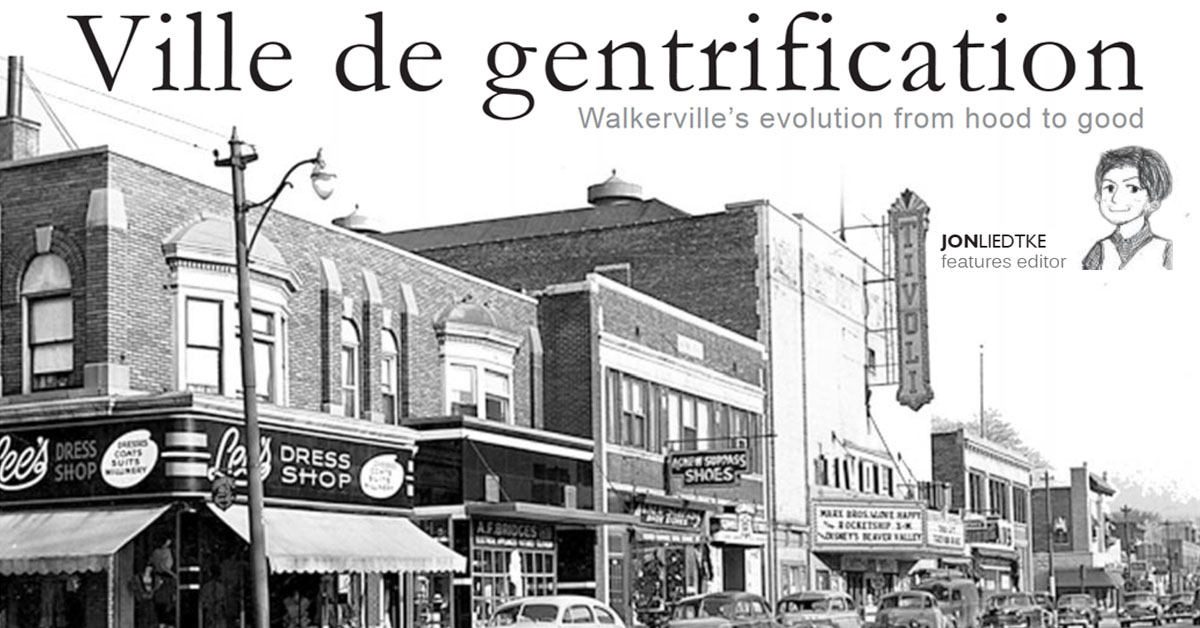UWindsor Lance
Issue 14, Volume 85
Oct. 4, 2012
Jon Liedtke
It is said that it takes a village to raise a child In Walkerville, it takes a community to raise a neighbourhood.
The central neighbourhood recently celebrated the second annual Walkerville Rocks Street Festival over the weekend. With 10 new businesses opening in Walkerville’s Wyandotte East shopping and dining district in 2012, it’s no surprise that the borough is celebrating.
The streets were bustling with patrons, independent entrepreneurs and the young and old alike as customers ventured into the area’s shops, restaurants, bars and other businesses. It was like any Toronto street festival, except the attendees weren’t weighed down by seven figure mortgages.
“It a perfect place to live,” said Linda Balkissoon, who moved to the area from Toronto for what she calls the ‘value of life over real-estate cost ratio.’
“It’s become so trendy, we have indie art galleries, vintage shops, great little cafes and restaurants, even a paperie now. All we need is a luxury dog grooming place and a gourmet cupcake shop and we will receive the quaint upper middle class neighbourhood award,” she laughed.
Louise Jones the owner of vintage clothing shop Jones and Co., absolutely loves the Walkerville area. She focuses on selling quality items that remind her of growing up and draws correlation to her neighbourhood. “Something with some texture, some diversity, very much the kind of thing we are looking for in our city.”
Jones, who has operated her Wyandotte Street shop for close to a decade, cites the growing appeal of Walkerville to the “neighbourhood feeling, the sidewalks, the diversity. In Tecumseh (where Jones used to lived), it’s like everything is the same.”
“We’ve gotten to a tipping point people can tell when something cool is happening … people respect what is happening in the area, and they are willing to invest for that reason.”
Jones has noticed that other business owners are willing to support each other, and “that doesn’t always happen [everywhere]. Sometimes, there is a lot of fear amongst people. I’m not just interested in building my store; I’m interested in building my community, my city.”
Mike Brkovich, a local real estate developer, owns several properties in Walkerville and started investing in the area roughly 20 years ago. Brkovich fell in love with the character, architecture and history of Walkerville.
“Originally, when I bought buildings here in the early 90s, you could tell there was a lot of that urban decay and a lot of boarded up storefronts,” commented Brkovich, adding, “l think over the last 15-20 years, the biggest change is actually the residential side of it: people are moving back into the neighbourhood, repairing the homes, investing in their own homes … that lends foot traffic to the retail.”
The biggest thing that Brkovich has noticed is the level of ownership in the neighbourhood as “the people investing in the buildings and the businesses want to be here. They’re not absentee landowners, most of the people that own the businesses or buildings are here all the time.”
Brkovich commented that the majority of development in the Walkerville area has been facilitated by the business owners themselves without a lot of intervention from the city.
The manager of the recently revamped and reopened Walkerville Brewery, Chris Ryan, thinks of Walkerville as a ‘work and live’ community.
“Everyone is very supportive of each other,” said Ryan. “l think we’re all
really trying to do the same thing; bring more people to the area and spread out the wealth a little bit.”
While many people are saying ‘Walkerville is up and coming, Elaine Weeks, managing editor for Walkerville Publishing, is aware that everything is cyclical.
“Hopefully, this will continue going up. Even though Windsor has been suffering from the global slump in 2008, Walkerville is still a bright spot,” she said.
Weeks appreciates the community spirit of Walkerville, commenting that, “Businesses working together is mutually beneficial. You have to employ synergy, we need to work together in order to survive.”
Penny Jane’s Vintage moved into the Walkerville area last year because of the growing hipster buzz.
“It’s trendy,” said owner Jane Renaud. “I just thought that with vintage clothing and jewelry it would be worthwhile for me as a businesswoman.”
Renaud commented that since she moved into the area, she has had customers referred to her by the owners of Jones and Co. and retro furniture shop Timeless Treasures. “That speaksvolumes about the neighbourhood and the vendors. They just want everyone to succeed, because if I do well, more people come into the area, and they do well.”
Lindsay Gammon moved into the Walkerville area because it reminded her of living in Toronto and Ottawa.
“I always enjoyed that type of community … know your neighbours, have like-minded businesses in the area that have that more urban vibe of a vibrant area that people go to shop and eat.”
Gammon moved her trendy maternity and baby shop, Bump, to Walkerville in 2008, and this year has opened Poppy Paperie & Gifts.
“Everyone is supportive of each other,” explained Gammon. “I think we all complement each other very well. I think we all draw a different clientele and I think that we each offer something different.”
Vile de gentrification
Issue 14, Volume 85
Oct. 4, 2012
Jon Liedtke
Page 7
Jon Liedtke was the Features and Opinions Editor, Advertising Manager and Deficit Consultant at the UWindsor Lance.




Leave a Reply